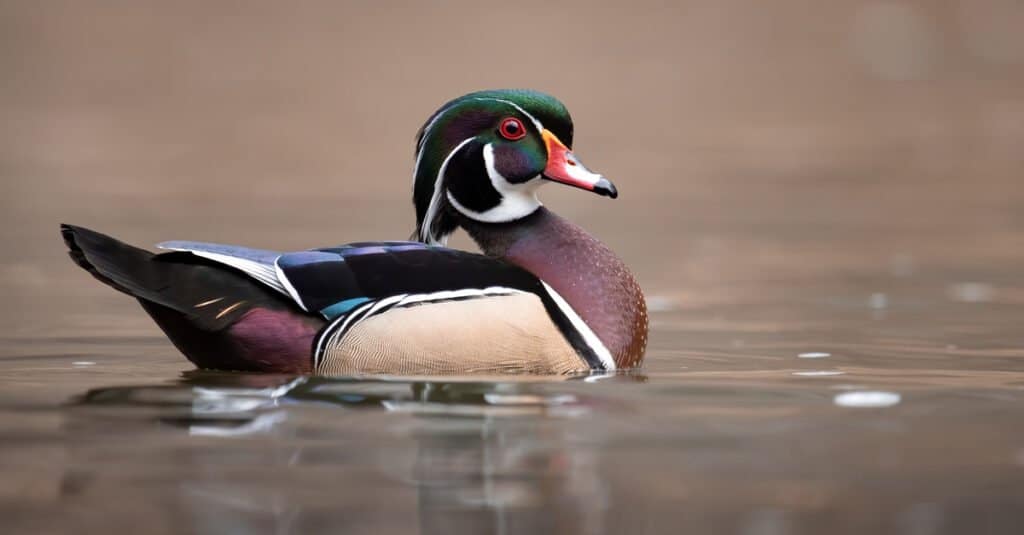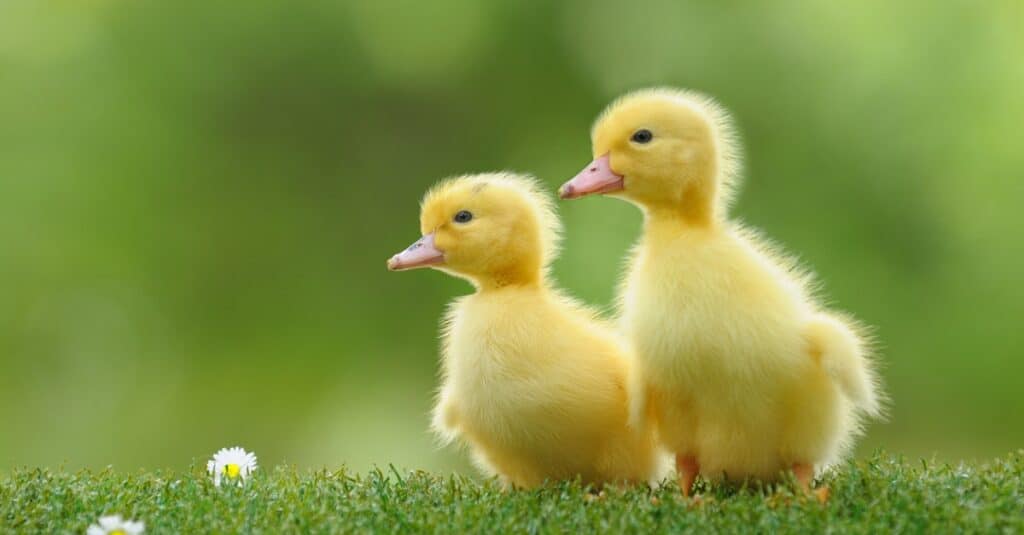Ducks are a large group of aquatic birds known as waterfowl. They belong to the family Anatidae together with geese and swans. But as a group, the majority of these birds are smaller than geese and swans. Ducks reside in freshwaters, such as ponds and lakes, but some species live in salt or brackish water.
Various species and animals have varying behavioral patterns, such as adaptation methods, sleeping habits, and where they sleep once night falls. In this article, you’d learn all you need to know about how and where ducks sleep.
Where Do Ducks Sleep?

Ducks sleep floating on water.
©Millie Bond – Copyright A-Z Animals
Ducks mostly sleep floating on water. There are grooming processes ducks undergo, and sleeping is usually the last. The first grooming process is foraging, followed by bathing, after which the preening of their features becomes next and then lastly, sleeping.
Ducks are often not too picky about their sleeping space. They are flexible when it comes to their choice of where to sleep. For example, a species of ducks known as mallards can sleep both on land and water. Another species known as Muscovy ducks can also roost (sleep) on the ground.
However, the sleeping pattern of ducks is dependent on specific environmental factors such as changes in season. Whenever the weather is cold, they tend to be active at night by moving around a lot, and when the weather is warmer, they tend to feed a lot.
How Do Ducks Sleep?

Ducks are always alert and can sleep with one eye open.
©Harry Collins Photography/Shutterstock.com
As for how ducks sleep, they are usually prone to attacks when sleeping. This is why they developed unique sleeping habits that help them adapt to the challenging environment and survive in the wild. Some of these habits include:
Sleeping With One Eye Open
Ducks tend to sleep in a group setting, having themselves lined in a row. The birds holding each end of the row are supposed to have light sleep and remain alert for closeby movements. Thus, these birds at the row end sleep with one of their eyes open, as the group’s assigned guards.
Half Part of a Duck’s Brain Remains Active While Sleeping
Sleeping with one eye open makes the ducks leave half of their brains awake while sleeping. As a result, ducks will be able to sleep with half of their brains while the remaining half remains alert for potential predators.
Various Sleeping Postures
These postures include:
- Standing on one leg while sleeping helps reduce heat loss through the bare legs.
- Resting their heads on their backs by rotating their heads backward. This phenomenon is common in heavier ducks.
- Resting their heads on their chests by pulling their necks backward.
Semi-Nocturnal In Nature
Ducks are semi-nocturnal because they do not use all their nights to sleep. They still stay active during night-time and groom one another, chit-chat, migrate or relocate in cases of severe weather conditions. However, older ducks sleep more than young ducks because aging tends to wear ducks out.
Types of Ducks
Below are 12 types of ducks all birders should know:
- Eiders
- Scoters
- Sea-ducks
- Dabbling ducks
- Stiff tails
- Teals
- Domestic ducks
- Perching ducks
- Goldeneye ducks
- Whistling ducks
- Mergansers
- Diving ducks
These species of ducks can be found in different habitats such as Northern Arctic habitat (eiders can be found here), marine habitat (as in scoters), coastal habitat (as in sea-ducks), etc.
Where Do Ducks Live in the Winter?
During winter, ducks leave northern nesting areas and spend most of their time in the Southern portions of the United States, as well as along the coastal fringes where there are mild weather conditions. However, ducks can withstand cold temperatures. But once their food source is eliminated, they leave the northern areas searching for more favorable temperatures.
Where Do Baby Ducks Sleep?

Ducklings, like ducks, sleep floating on water.
©iStock.com/therry
The baby (young) of ducks are usually called ducklings. They are just like their parents and also sleep floating on water. Ducklings always remain huddled close to their parents. This is because their mothers make the external heat baby ducks need. Also, regardless of the type of species and breed of duckling, it will always roost along with its parent for warmth and protection from predators until it reaches about two months.
How Many Hours Do Ducks Sleep?
Ducks typically need approximately 10.8 hours of sleep per day. Their unique ability to rest one half of their brain while the other remains alert helps them stay vigilant, especially when sleeping on water, where they could be vulnerable to predators.
It’s typical for ducklings, particularly when they’re very young, to engage in extended periods of daytime slumber. These little ones need ample sleep to facilitate their growth and maturation, often snoozing for as much as 20 hours each day.
Some Interesting Facts about Ducks
- Ducks can be found on all continents except Antarctica.
- There are about 120 varying species of ducks.
- They have been domesticated as farm animals and pets for over 500 years.
- Wild ducks can live for up to 20 years or more, while domestic ducks can live for 10-15 years or less.
- Ducks have an excellent vision.
- Their three eyelids are clear.
- All ducks have great waterproof feathers. This is due to their intricate feather structure, and a waxy coating spread upon each feather during preening.
- Female ducks are known as hens, while male ducks are drakes.
- Through preening, the feathers of ducks are kept clean. This is usually done by placing their heads in funny positions and also putting beaks into their body. They preen themselves very frequently.
- The feet of ducks neither consist of blood vessels nor nerves. This means their feet do not feel cold, which allows them to swim in icy water, as well as walk on snow and ice.
The photo featured at the top of this post is © iStock.com/Anolis01
Thank you for reading! Have some feedback for us? Contact the AZ Animals editorial team.






